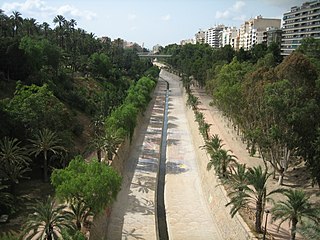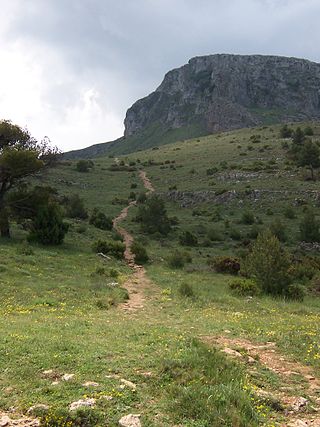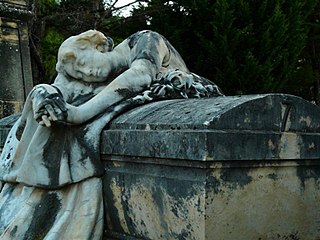
Alicante is a province of eastern Spain, in the southern part of the Valencian Community. It is the second most populated Valencian province. Likewise, the second and third biggest cities in the Valencian Community are located in this province.

Banyeres de Mariola is a settlement and a municipality in the north of the province of Alicante (Spain), 860 metres above sea level, with a population of 7,500. The main employer is the local textile industry. The town has a Moorish castle that dates from 1214, and is surrounded by mountains, almond and olive trees.

Moros y Cristianos or Moros i Cristians, literally in English Moors and Christians, is a set of festival activities which are celebrated in many towns and cities of Spain, mainly in the southern Valencian Community. According to popular tradition the festivals commemorate the battles, combats and fights between Moors and Christians during the period known as Reconquista. There are also festivals of Moros y Cristianos in Spanish America.

Muro de Alcoy or Muro d'Alcoi, also briefly called Muro is a town and municipality located in the comarca of Comtat, in the province of Alicante, Spain, lying at the foot of the Serra de Mariola. As of 2009, it has a total population of c. 8,900 inhabitants. The economy of Muro de Alcoy is based on textile industry, manufacture of plastic products and furniture and agriculture.

Agres is a town and municipality in the comarca of Comtat, in the province of Alicante, Valencian Community, Spain.

The Vinalopó is a small river flowing through the Alicante province, of Spain. It flows from north to south and, with a length of 81 km., it is the longest of the rivers which flows for its entire length within the limits of this province. It discharges into the Mediterranean at Salinas de Santa Pola.
Gaianes is a municipality in the comarca of Comtat, Alicante, Valencia, Spain.

The Serpis is a short coastal river in the provinces of Alicante and Valencia, in Spain.

The Serra Mariola Natural Park is a mountain range in the Valencian Community, Spain, one of the most peripheral offsprings of the Baetic System. Most of its territory is included in a natural park founded in 2002, covering an area of 17,257 ha. The park is surrounded by the towns of Cocentaina and Bocairent and the cities of Ontinyent and Alcoy.

Alcoy is an industrial and university city, region and municipality located in the Valencian Community, Spain. The Serpis river crosses the municipal boundary of Alcoy. The local authority reported a population of 61,135 residents in 2018.

The Castle of Cocentaina, located in the municipality of Cocentaina, Alicante, Spain, is a 14th-century medieval building which stands on a rocky mound of 765 m. The castle structure, recently restored, is one of the town's symbols. The tower is a square two-story structure. On the first floor there is an open patio with a well, a chapel and a warehouse. On the upper floor, where the lords lived, there is a cornice with battlements and a path for guards. The castle is a good example of military gothic style.

The Palace of the Counts of Cocentaina, located in the municipality of Cocentaina, Alicante, Spain, is a 14th-century medieval building. This building originated as an old fortress with four halls and four towers on donjons crowned by merlons.

The castle of Banyeres (Alicante), Valencian Community (Spain), is an Almohad fortress built in the 13th century, which is situated on the tossal de l'Àguila (Valencian), English: 'Hill of the Eagle', in the geographical center of Banyeres, with an elevation of 830 meters above the sea level.

The Font Roja Natural Park is a natural park situated in Alcoy, in the autonomous community of Valencia, in eastern Spain.

The Llonja de Sant Jordi is a room of exhibitions of Alcoy (Alicante), Valencian Community, located under the floor of the Plaça d'Espanya.
Timoteo Briet Montaud was a Spanish architect, one of the main architects of the Art Nouveau in Alcoy and the Valencian Art Nouveau.

Vicente Juan Pascual Pastor was a spanish architect, one of the main architects of the Art Nouveau in Alcoy and the Valencian Art Nouveau.

Valencian Art Nouveau is the historiographic denomination given to an art and literature movement associated with the Art Nouveau in the Valencian Community, in Spain.

The Casa del Pavo is a private building at 15 Sant Nicolau Street, in the city center of Alcoy (Alicante), Valencian Community, Spain. It is one of the main works of the Art Nouveau in Alcoy.

The Cementerio de San Antonio Abad(transl. Saint Anthony Cemetery) or Cementeri d'Alcoi is a cemetery located in Alcoy (Alicante), Spain.



















